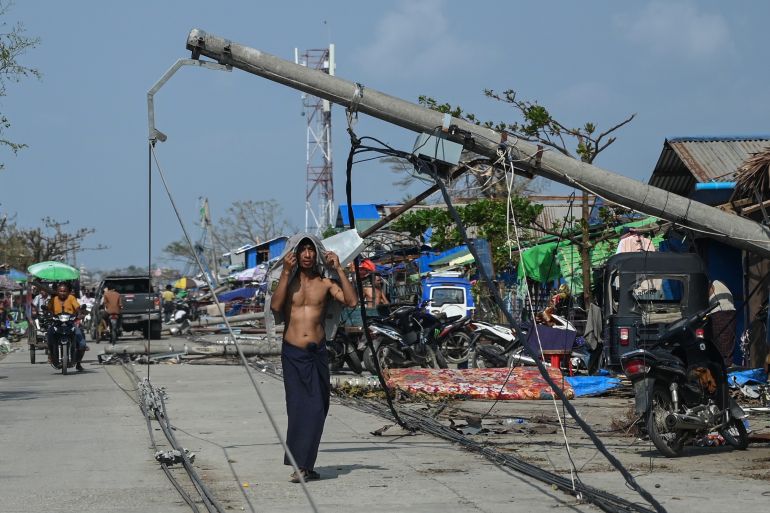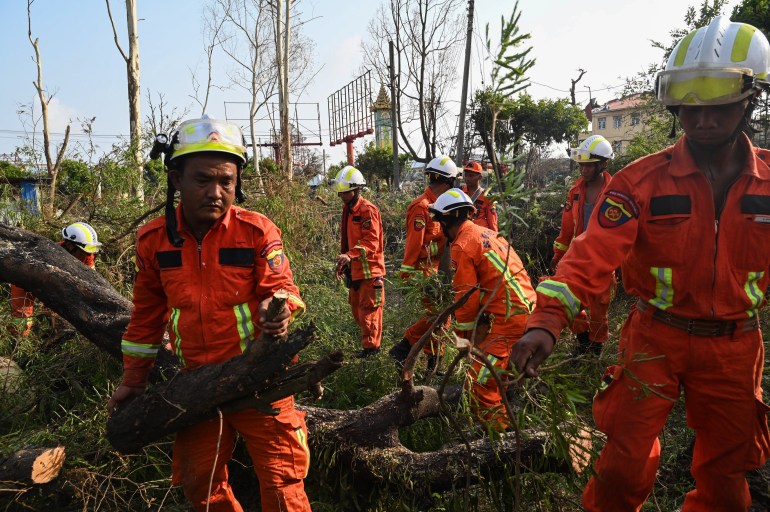Official death toll in Myanmar cyclone rises to at least 54
India is sending more aid to Yangon, but communications remain difficult, hampering the disaster response.

At least 54 people were killed and more than 185,000 buildings damaged by Cyclone Mocha which swept into the country’s northwest last weekend, according to state television MRTV.
But communication problems in the affected areas, where infrastructure was already poor, and the military government’s tight control over information mean the actual extent of casualties and destruction remains unclear.
Keep reading
list of 4 itemsCyclone Mocha may have killed ‘hundreds’ in Myanmar’s Rakhine
Photos: Cyclone Mocha batters Myanmar, Bangladesh
Flooding, communications blackout as Cyclone Mocha hits Myanmar
People living in the area have told Al Jazeera that “hundreds” probably died, damage was significant and widespread, and that they were still waiting for help to arrive.
The powerful cyclone roared in from the Bay of Bengal on Sunday bringing winds up to 250 kilometres per hour (155mph) and torrential rain to the coastal stretch from Sittwe in Myanmar’s Rakhine state to Cox’s Bazar in southern Bangladesh. It weakened to a tropical depression on Monday as it moved inland.
The United Nations Office for the Coordination of Humanitarian Affairs (UNOCHA) said the destruction of homes and infrastructure was widespread in Rakhine.
“Urgent needs include shelter, clean water, food assistance and healthcare services,” it said. “There are rising concerns in flooded areas about the spread of waterborne disease and the movement of landmines,” a legacy of civil conflict that has been going on in Myanmar for decades.
“The impact of the cyclone was also felt heavily in the country’s northwest where houses were blown or washed away. Strong winds and rains have also damaged camps for displaced people in Kachin state,” UNOCHA said.
A fourth Indian Navy ship carrying relief material was expected in Yangon, Myanmar’s largest city, on Friday, India’s External Affairs Minister Subrahmanyam Jaishankar said in a tweet. Yangon is south of the cyclone-hit area.
“The ships are carrying emergency food items, tents, essential medicines, water pumps, portable generators, clothes, sanitary and hygiene items,” Jaishankar added.
The United Kingdom announced on Friday that it would provide 2 million British pounds in humanitarian support for an estimated 175,000 people left without shelter or access to clean water.
“By partnering with organisations already on the ground in northwest Myanmar, we will be able to quickly deliver the lifesaving support that survivors need,” International Development Minister Andrew Mitchell said in a statement on Wednesday.

Refugee camps in Bangladesh, where at least 740,000 of Myanmar’s mostly Muslim Rohingya minority fled in 2017 to escape a brutal military crackdown, escaped the worst of the storm thanks in part to a well-organised evacuation.
Housing was severely damaged, but no deaths were reported.
Many of the Rohingya who remained in Rakhine were less fortunate. Forced into crowded and low-lying displacement camps on the outskirts of Sittwe, their bamboo homes were no match for Cyclone Mocha’s driving winds.
There are fears that there could be many deaths among the Rohingya, but independent confirmation is difficult because of the damage caused by the storm and longstanding government restrictions on access to Rakhine.
“Bridges have collapsed to the west of downtown Sittwe following #CycloneMocha, leaving only one access route to camps in the area,” Ben Small, who works for the UNDP in Myanmar, said on Twitter. “This further hinders humanitarian access. They urgently need repairing.”
The Burmese Rohingya Organisation UK (BROUK) said on Wednesday that at least 400 Rohingya in the camps had been killed. About 130,000 Rohingya live in the camps with severe restrictions on their movements.
“No humanitarian aid has reached the affected Rohingya people. The Burmese military are not helping them. The international community needs to act urgently to reach survivors with medical and humanitarian aid, otherwise many more will die,” Tun Khin, BROUK president said in the statement.
Rakhine state spokesperson and attorney general Hla Thein issued a qualified denial of reports that hundreds of people had died, saying that only 46 deaths in the state had been confirmed so far, from other ethnic groups as well as the Rohingya. He said confirmation of further deaths would require investigations, including inspections of burial places.
India extends a hand of friendship to the people of Myanmar affected by #CycloneMocha. #OperationKaruna underway. Three Indian Navy ships carrying relief material reached Yangon today. A fourth ship will be reaching tomorrow.
The ships are carrying emergency food items, tents,… pic.twitter.com/Ot8Ohm2jpn
— Dr. S. Jaishankar (@DrSJaishankar) May 18, 2023
Hla Thein said the authorities had warned people in the camps to move to safer places days before the cyclone hit, but some stayed until seawater poured in, wreaking destruction. He said the government was trying to send relief supplies to affected areas and there were no restrictions on relief organisations in sending aid, an assertion that could not immediately be confirmed.
A leader of a local charity group helping to collect data about casualties inside the Rohingya camps and nearby villages said on Thursday that the bodies of at least 116 people from 15 camps and villages, including 32 children and 46 women, had been given burial rites.
He requested that neither he nor his organisation be identified because of possible punishment by the authorities.
The charity worker said reports of higher death tolls may have resulted from misunderstandings due to communication breakdowns which also prevented the authorities from getting an accurate count.